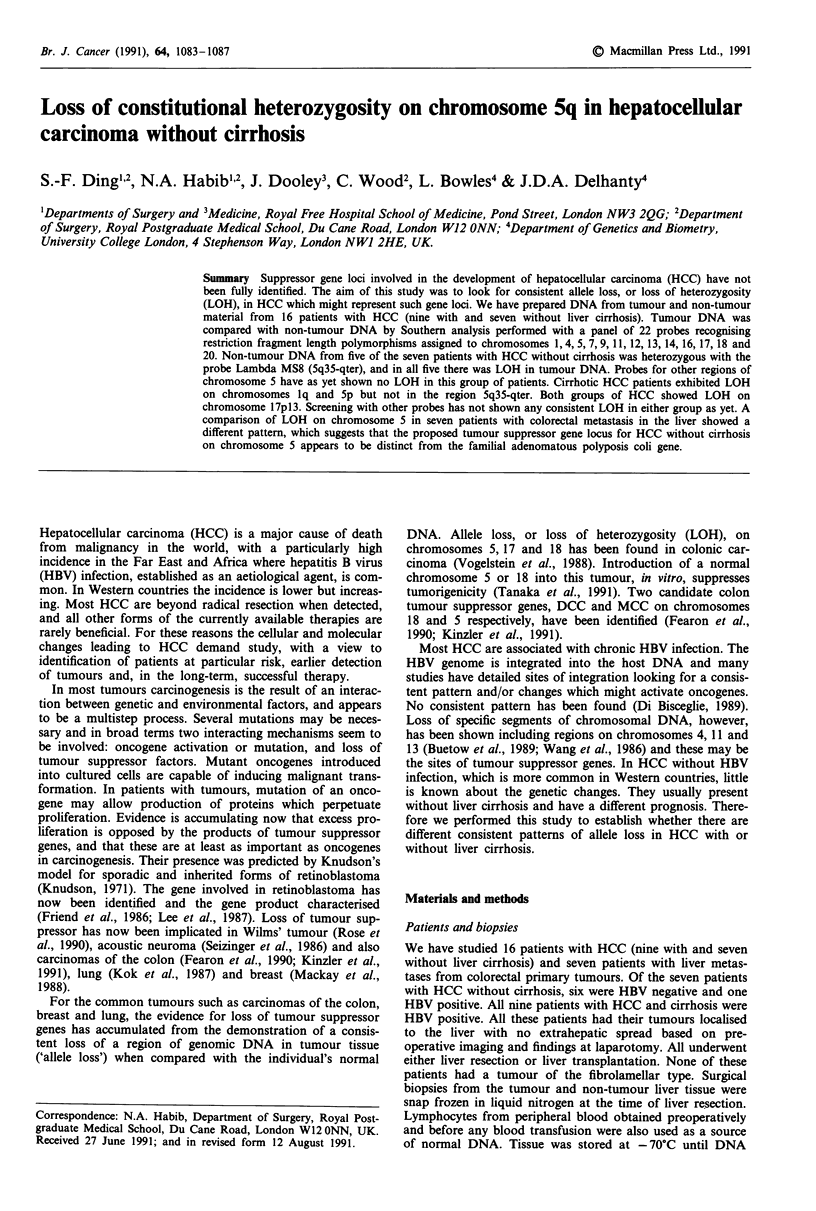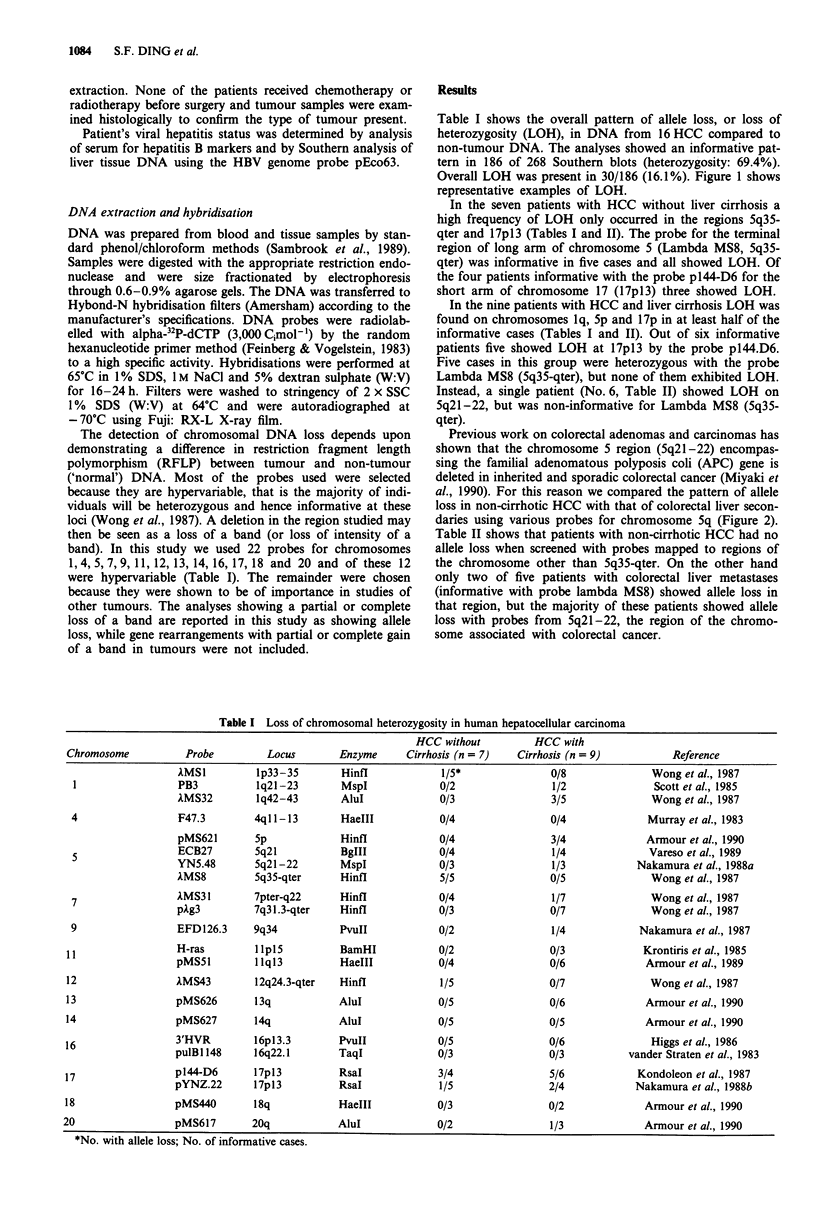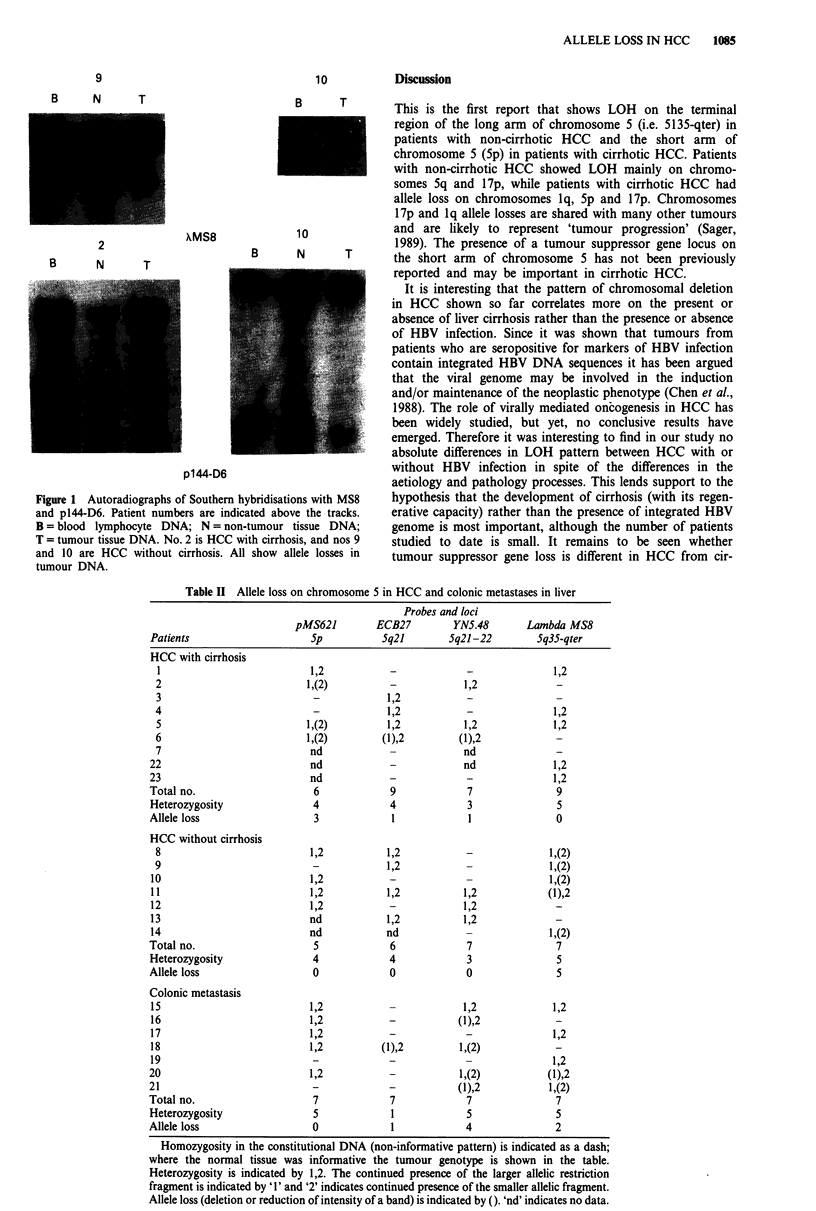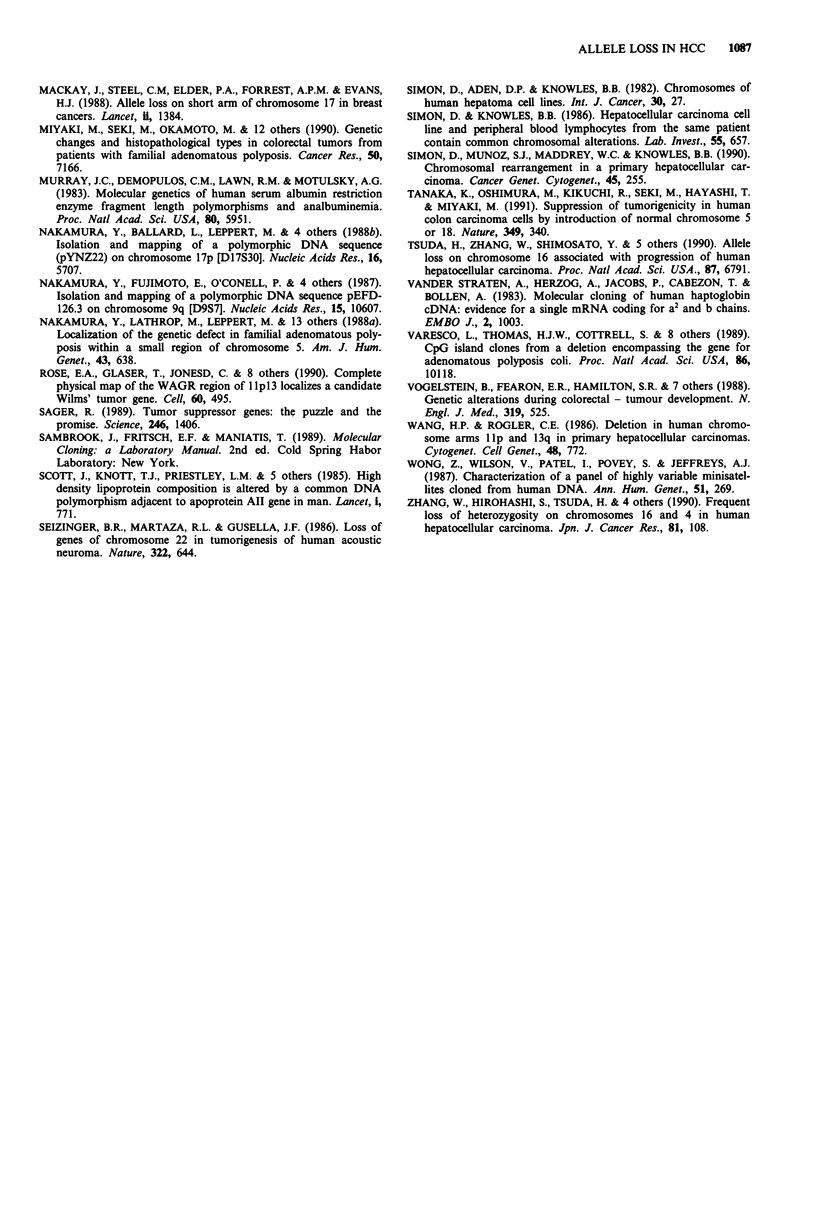Abstract
Suppressor gene loci involved in the development of hepatocellular carcinoma (HCC) have not been fully identified. The aim of this study was to look for consistent allele loss, or loss of heterozygosity (LOH), in HCC which might represent such gene loci. We have prepared DNA from tumour and non-tumour material from 16 patients with HCC (nine with and seven without liver cirrhosis). Tumour DNA was compared with non-tumour DNA by Southern analysis performed with a panel of 22 probes recognising restriction fragment length polymorphisms assigned to chromosomes 1, 4, 5, 7, 9, 11, 12, 13, 14, 16, 17, 18 and 20. Non-tumour DNA from five of the seven patients with HCC without cirrhosis was heterozygous with the probe Lambda MS8 (5q35-qter), and in all five there was LOH in tumour DNA. Probes for other regions of chromosome 5 have as yet shown no LOH in this group of patients. Cirrhotic HCC patients exhibited LOH on chromosomes 1q and 5p but not in the region 5q35-qter. Both groups of HCC showed LOH on chromosome 17p13. Screening with other probes has not shown any consistent LOH in either group as yet. A comparison of LOH on chromosome 5 in seven patients with colorectal metastasis in the liver showed a different pattern, which suggests that the proposed tumour suppressor gene locus for HCC without cirrhosis on chromosome 5 appears to be distinct from the familial adenomatous polyposis coli gene.
Full text
PDF




Images in this article
Selected References
These references are in PubMed. This may not be the complete list of references from this article.
- Armour J. A., Povey S., Jeremiah S., Jeffreys A. J. Systematic cloning of human minisatellites from ordered array charomid libraries. Genomics. 1990 Nov;8(3):501–512. doi: 10.1016/0888-7543(90)90037-u. [DOI] [PubMed] [Google Scholar]
- Armour J. A., Wong Z., Wilson V., Royle N. J., Jeffreys A. J. Sequences flanking the repeat arrays of human minisatellites: association with tandem and dispersed repeat elements. Nucleic Acids Res. 1989 Jul 11;17(13):4925–4935. doi: 10.1093/nar/17.13.4925. [DOI] [PMC free article] [PubMed] [Google Scholar]
- Buetow K. H., Murray J. C., Israel J. L., London W. T., Smith M., Kew M., Blanquet V., Brechot C., Redeker A., Govindarajah S. Loss of heterozygosity suggests tumor suppressor gene responsible for primary hepatocellular carcinoma. Proc Natl Acad Sci U S A. 1989 Nov;86(22):8852–8856. doi: 10.1073/pnas.86.22.8852. [DOI] [PMC free article] [PubMed] [Google Scholar]
- Di Bisceglie A. M. Hepatocellular carcinoma: molecular biology of its growth and relationship to hepatitis B virus infection. Med Clin North Am. 1989 Jul;73(4):985–997. doi: 10.1016/s0025-7125(16)30649-6. [DOI] [PubMed] [Google Scholar]
- Feinberg A. P., Vogelstein B. A technique for radiolabeling DNA restriction endonuclease fragments to high specific activity. Anal Biochem. 1983 Jul 1;132(1):6–13. doi: 10.1016/0003-2697(83)90418-9. [DOI] [PubMed] [Google Scholar]
- Friend S. H., Bernards R., Rogelj S., Weinberg R. A., Rapaport J. M., Albert D. M., Dryja T. P. A human DNA segment with properties of the gene that predisposes to retinoblastoma and osteosarcoma. Nature. 1986 Oct 16;323(6089):643–646. doi: 10.1038/323643a0. [DOI] [PubMed] [Google Scholar]
- Higgs D. R., Wainscoat J. S., Flint J., Hill A. V., Thein S. L., Nicholls R. D., Teal H., Ayyub H., Peto T. E., Falusi A. G. Analysis of the human alpha-globin gene cluster reveals a highly informative genetic locus. Proc Natl Acad Sci U S A. 1986 Jul;83(14):5165–5169. doi: 10.1073/pnas.83.14.5165. [DOI] [PMC free article] [PubMed] [Google Scholar]
- Kiechle-Schwarz M., Scherer G., Kovacs G. No evidence for loss of alleles at 11p in HBV negative hepatocellular carcinomas. Genes Chromosomes Cancer. 1990 Mar;1(4):312–314. doi: 10.1002/gcc.2870010409. [DOI] [PubMed] [Google Scholar]
- Kinzler K. W., Nilbert M. C., Vogelstein B., Bryan T. M., Levy D. B., Smith K. J., Preisinger A. C., Hamilton S. R., Hedge P., Markham A. Identification of a gene located at chromosome 5q21 that is mutated in colorectal cancers. Science. 1991 Mar 15;251(4999):1366–1370. doi: 10.1126/science.1848370. [DOI] [PubMed] [Google Scholar]
- Knudson A. G., Jr Mutation and cancer: statistical study of retinoblastoma. Proc Natl Acad Sci U S A. 1971 Apr;68(4):820–823. doi: 10.1073/pnas.68.4.820. [DOI] [PMC free article] [PubMed] [Google Scholar]
- Kok K., Osinga J., Carritt B., Davis M. B., van der Hout A. H., van der Veen A. Y., Landsvater R. M., de Leij L. F., Berendsen H. H., Postmus P. E. Deletion of a DNA sequence at the chromosomal region 3p21 in all major types of lung cancer. Nature. 1987 Dec 10;330(6148):578–581. doi: 10.1038/330578a0. [DOI] [PubMed] [Google Scholar]
- Kondoleon S., Vissing H., Luo X. Y., Magenis R. E., Kellogg J., Litt M. A hypervariable RFLP on chromosome 17p13 is defined by an arbitrary single copy probe p144-D6 [HGM9 No. D17S34]. Nucleic Acids Res. 1987 Dec 23;15(24):10605–10605. doi: 10.1093/nar/15.24.10605. [DOI] [PMC free article] [PubMed] [Google Scholar]
- Krontiris T. G., DiMartino N. A., Colb M., Parkinson D. R. Unique allelic restriction fragments of the human Ha-ras locus in leukocyte and tumour DNAs of cancer patients. 1985 Jan 31-Feb 6Nature. 313(6001):369–374. doi: 10.1038/313369a0. [DOI] [PubMed] [Google Scholar]
- Lee W. H., Bookstein R., Hong F., Young L. J., Shew J. Y., Lee E. Y. Human retinoblastoma susceptibility gene: cloning, identification, and sequence. Science. 1987 Mar 13;235(4794):1394–1399. doi: 10.1126/science.3823889. [DOI] [PubMed] [Google Scholar]
- Mackay J., Steel C. M., Elder P. A., Forrest A. P., Evans H. J. Allele loss on short arm of chromosome 17 in breast cancers. Lancet. 1988 Dec 17;2(8625):1384–1385. doi: 10.1016/s0140-6736(88)90584-3. [DOI] [PubMed] [Google Scholar]
- Miyaki M., Seki M., Okamoto M., Yamanaka A., Maeda Y., Tanaka K., Kikuchi R., Iwama T., Ikeuchi T., Tonomura A. Genetic changes and histopathological types in colorectal tumors from patients with familial adenomatous polyposis. Cancer Res. 1990 Nov 15;50(22):7166–7173. [PubMed] [Google Scholar]
- Murray J. C., Demopulos C. M., Lawn R. M., Motulsky A. G. Molecular genetics of human serum albumin: restriction enzyme fragment length polymorphisms and analbuminemia. Proc Natl Acad Sci U S A. 1983 Oct;80(19):5951–5955. doi: 10.1073/pnas.80.19.5951. [DOI] [PMC free article] [PubMed] [Google Scholar]
- Nakamura Y., Ballard L., Leppert M., O'Connell P., Lathrop G. M., Lalouel J. M., White R. Isolation and mapping of a polymorphic DNA sequence (pYNZ22) on chromosome 17p [D17S30]. Nucleic Acids Res. 1988 Jun 24;16(12):5707–5707. doi: 10.1093/nar/16.12.5707. [DOI] [PMC free article] [PubMed] [Google Scholar]
- Nakamura Y., Fujimoto E., O'Connell P., Leppert M., Lathrop G. M., Lalouel J. M., White R. Isolation and mapping of a polymorphic DNA sequence pEFD126.3 on chromosome 9q (D9S7). Nucleic Acids Res. 1987 Dec 23;15(24):10607–10607. doi: 10.1093/nar/15.24.10607. [DOI] [PMC free article] [PubMed] [Google Scholar]
- Nakamura Y., Lathrop M., Leppert M., Dobbs M., Wasmuth J., Wolff E., Carlson M., Fujimoto E., Krapcho K., Sears T. Localization of the genetic defect in familial adenomatous polyposis within a small region of chromosome 5. Am J Hum Genet. 1988 Nov;43(5):638–644. [PMC free article] [PubMed] [Google Scholar]
- Rose E. A., Glaser T., Jones C., Smith C. L., Lewis W. H., Call K. M., Minden M., Champagne E., Bonetta L., Yeger H. Complete physical map of the WAGR region of 11p13 localizes a candidate Wilms' tumor gene. Cell. 1990 Feb 9;60(3):495–508. doi: 10.1016/0092-8674(90)90600-j. [DOI] [PubMed] [Google Scholar]
- Sager R. Tumor suppressor genes: the puzzle and the promise. Science. 1989 Dec 15;246(4936):1406–1412. doi: 10.1126/science.2574499. [DOI] [PubMed] [Google Scholar]
- Scott J., Knott T. J., Priestley L. M., Robertson M. E., Mann D. V., Kostner G., Miller G. J., Miller N. E. High-density lipoprotein composition is altered by a common DNA polymorphism adjacent to apoprotein AII gene in man. Lancet. 1985 Apr 6;1(8432):771–773. doi: 10.1016/s0140-6736(85)91443-6. [DOI] [PubMed] [Google Scholar]
- Seizinger B. R., Martuza R. L., Gusella J. F. Loss of genes on chromosome 22 in tumorigenesis of human acoustic neuroma. Nature. 1986 Aug 14;322(6080):644–647. doi: 10.1038/322644a0. [DOI] [PubMed] [Google Scholar]
- Simon D., Aden D. P., Knowles B. B. Chromosomes of human hepatoma cell lines. Int J Cancer. 1982 Jul 15;30(1):27–33. doi: 10.1002/ijc.2910300106. [DOI] [PubMed] [Google Scholar]
- Simon D., Knowles B. B. Hepatocellular carcinoma cell line and peripheral blood lymphocytes from the same patient contain common chromosomal alterations. Lab Invest. 1986 Dec;55(6):657–665. [PubMed] [Google Scholar]
- Simon D., Munoz S. J., Maddrey W. C., Knowles B. B. Chromosomal rearrangements in a primary hepatocellular carcinoma. Cancer Genet Cytogenet. 1990 Apr;45(2):255–260. doi: 10.1016/0165-4608(90)90091-n. [DOI] [PubMed] [Google Scholar]
- Tanaka K., Oshimura M., Kikuchi R., Seki M., Hayashi T., Miyaki M. Suppression of tumorigenicity in human colon carcinoma cells by introduction of normal chromosome 5 or 18. Nature. 1991 Jan 24;349(6307):340–342. doi: 10.1038/349340a0. [DOI] [PubMed] [Google Scholar]
- Tsuda H., Zhang W. D., Shimosato Y., Yokota J., Terada M., Sugimura T., Miyamura T., Hirohashi S. Allele loss on chromosome 16 associated with progression of human hepatocellular carcinoma. Proc Natl Acad Sci U S A. 1990 Sep;87(17):6791–6794. doi: 10.1073/pnas.87.17.6791. [DOI] [PMC free article] [PubMed] [Google Scholar]
- Varesco L., Thomas H. J., Cottrell S., Murday V., Fennell S. J., Williams S., Searle S., Sheer D., Bodmer W. F., Frischauf A. M. CpG island clones from a deletion encompassing the gene for adenomatous polyposis coli. Proc Natl Acad Sci U S A. 1989 Dec;86(24):10118–10122. doi: 10.1073/pnas.86.24.10118. [DOI] [PMC free article] [PubMed] [Google Scholar]
- Vogelstein B., Fearon E. R., Hamilton S. R., Kern S. E., Preisinger A. C., Leppert M., Nakamura Y., White R., Smits A. M., Bos J. L. Genetic alterations during colorectal-tumor development. N Engl J Med. 1988 Sep 1;319(9):525–532. doi: 10.1056/NEJM198809013190901. [DOI] [PubMed] [Google Scholar]
- Wong Z., Wilson V., Patel I., Povey S., Jeffreys A. J. Characterization of a panel of highly variable minisatellites cloned from human DNA. Ann Hum Genet. 1987 Oct;51(Pt 4):269–288. doi: 10.1111/j.1469-1809.1987.tb01062.x. [DOI] [PubMed] [Google Scholar]
- Zhang W. D., Hirohashi S., Tsuda H., Shimosato Y., Yokota J., Terada M., Sugimura T. Frequent loss of heterozygosity on chromosomes 16 and 4 in human hepatocellular carcinoma. Jpn J Cancer Res. 1990 Feb;81(2):108–111. doi: 10.1111/j.1349-7006.1990.tb02534.x. [DOI] [PMC free article] [PubMed] [Google Scholar]
- vander Straten A., Herzog A., Jacobs P., Cabezón T., Bollen A. Molecular cloning of human haptoglobin cDNA: evidence for a single mRNA coding for alpha 2 and beta chains. EMBO J. 1983;2(6):1003–1007. doi: 10.1002/j.1460-2075.1983.tb01534.x. [DOI] [PMC free article] [PubMed] [Google Scholar]



